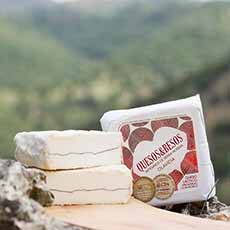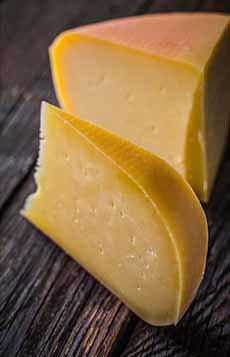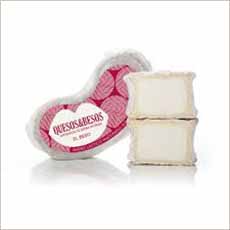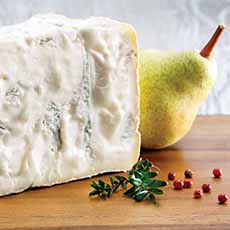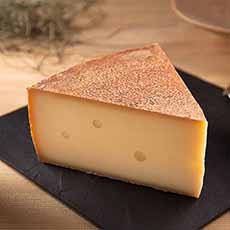The World’s Best Cheeses: The Top 10 From The World Cheese Awards
|
|
A soft, creamy goat’s milk cheese from Spain was named World Champion Cheese in Oviedo, Spain—where coincidentally this year’s World Cheese Awards was held. On Wednesday, November 3rd, Quesos y Besos’ Olavidia was voted to the top of the shortlist of 20 cheeses. This year, it is the best cheese on the planet. Produced by a husband-and-wife duo who established Quesos y Besos (Cheese and Kisses) in 2017, the cheese is made in the small town of Guarromán in Andalusia, in southern Spain. Head cheesemaker Silvia Peláez and her team of six people make the cheese entirely by hand. What makes a cheese #1 of 4,000+ entries? It has “everything” in exceptional amounts: appearance, aroma, texture, flavor, and originality. One of the judges in the final judging, Jason Hinds of the famed Neal’s Yard Dairy in the U.K., commented: “This cheese charmed me and stole my heart. This is unlike anything I’ve seen before. Its appearance is so original and it didn’t let me down. It’s unctuous, seductive, pillowy, warm and comforting.” The Peláezes come from a long line of shepherds, and decided to make a lactic cheese*, which is one of the oldest forms of fermentation. Lactic fermentation gives the cheese a buttery flavor; the the vegetation in the pasture where the goats graze provides and floral notes. The goat’s milk cheese is matured with Penicillium Candidum* and has a visually striking layer of olive stone (olive pit) ash running through its middle. John Farrand, managing director of the Guild of Fine Food, organizers of the World Cheese Awards, noted: “As the World Cheese Awards was founded over three decades ago to showcase the work of small artisan cheesemakers, it gives me immense pleasure to see a tiny family-run cheesemaking business taking top honours once again.” Ms. Peláez noted, “We’ve been making cheese for less than 5 years, so we never imagined we could win the world’s biggest prize in cheese so soon….To have such recognition from the World Cheese Awards judges is an incredible achievement and truly overwhelming.” And that’s not all. Her other cheese, Camembeso, took 6th place! In a close finale, second place was awarded to Epoisses Berthaut Perrière, made by Fromagerie Berthaut of France. All 4,000+ entries were judged in a single day, as 250 experts from 38 different countries. A super jury of 16 judges selected the World Champion Cheese from a 20-cheese shortlist. The Top 10 are below. The 4,000+ competing cheeses represented 45 different countries. Recent additions such as Colombia, India, and Japan joined established cheesemaking nations such as France, Italy, Spain, Switzerland, and the U.K. Thanks so much to Love Food of the U.K., whose review of the Top 20 finalists provided the tasting notes on these cheeses. You can review all 20 cheeses here. Styles of cheese are made by multiple producers—Caerphilly and Gorgonzola, for example, in these Top 10. The awards go to cheeses made by particular producers. So if you want the best Caerpohilly, for example, look for the one made by Trethowan’s Dairy. 1st Place: Olavidia, Quesos y Besos, Spain (photo #1) 2nd Place: Epoisses Berthaut Perrière, France The pungent cheese, with fans around the world, is on the official list of Protected Designation of Origin (PDO) products in Europe. It is only produced in central France. Made since the 16th century, Epoisses is a cow’s milk cheese with a washed rind, soft texture and creamy taste. This winning version, made by Fromagerie Berthaut in Burgundy, is washed with Marc de Bourgogne. (photo #2) 3rd Place: Eminence Grise, Tomme Chèvre Grise au Bleu, The Netherlands. This Dutch goat’s milk cheese is aged in caves in France. Made by Van der Heiden Kaas, it has delicate blue veins and a natural rind. Tomme Chèvre Grise au Bleu is ripened for at least six months and has a soft, mild taste. (photo #3) 4th Place: Baracska Semi-Hard Cheese, Hungary. The fatty milk of Hungarian cows grazing in the Váli Valley gives this cheese a particular richness and flavor of the pasture. Produced by Csíz Sajtműhely, it’s a flexible cheese that softly melts in the mouth with a sweet flavor, reminiscent of caramel. (photo #4) 5th Place: Twentse Bunkerkaas Geit, Netherlands. Another Dutch winner, Twentse Bunkerkaas Geit, is an aged goat’s milk cheese. It’s ripened in former ammunition bunkers for 25 weeks. Creamy and spicy with an intensely pure flavor. The producer is Zijerveld Food. (photo #5) 6th Place: Camembesos, Quesos y Besos, Spain. Another cheese from the first-place winning cheesemakers, Camembeso, a Camembert-like cheese is made from the milk of Malagueña goats. The cheese is pasteurized and matured for 60 days to ensure it has a wonderful depth of flavor. The flavor is light and buttery with floral and nutty notes. (photo #6) 7th Place: Gorwydd Caerphilly, Trethowan’s Dairy, United Kingdom. Gorwydd Caerphilly is a semi-soft cheese produced by Trethowan’s Dairy in North Somerset, England. Caerphilly is thought to have been created in Caerphilly, Wales to provide food for the local coal miners. Made with unpasteurized cow’s milk, it has a natural rind and a mushroomy cream layer around a springy, citrus core. The same dairy made the 14th-place-winning Pitchfork Vintage Cheddar. (photo #7) 8th Place: Montana Intenso, The Netherlands. Dutch producer MAAZ Cheese makes Montana Intenso, an extra-aged Gouda with a sweet and extra piquant taste flavor. It’s aged for 40 weeks on wooden shelves. (photo #8) There was a tie for 9th Place, meaning that there was no 10th Place winner this year. 9th Place: Gorgonzola Dolce DOP Caseificio Brusati, Italy. Made by Caseifico Brusati, this is a particularly creamy Gorgonzola Dolce. It can be eaten with a spoon! The aging process helps it develop its signature soft texture and slightly sweet flavor. It’s also beautiful to look at, with typical light blue and greenish veins that are irregular, as a result of the handmaking process. (photo #9) 9th Place: Vorarlberger Bergkäse g.U. – über 10 Monate, Austria. Vorarlberger Bergkäse is a traditionally produced hard cheese made from raw cow’s milk made in Vorarlberg, a mountainous province in westernmost Austria. The cheese is produced exclusively in the Alpine Bregenz Forest. Made from fresh hay milk, the cheese is matured for more than 10 months in special air-conditioned rooms, which delivers a unique hearty, spicy flavor. This cheese was also an award winner in 2014. g.U. is an abbreviation for Geschützte Ursprungsbezeichnung, German for Protected Designation of Origin or P.D.O. (photo #10) *Lactic cheeses, as opposed to the firmer rennet-set cheeses, are primarily made with little to no rennet and rely primarily on the action of the bacteria converting the milk lactose to lactic acid. When the milk acidity becomes high enough, the milk will coagulate even without the use of rennet. Here’s more about it. |
|
